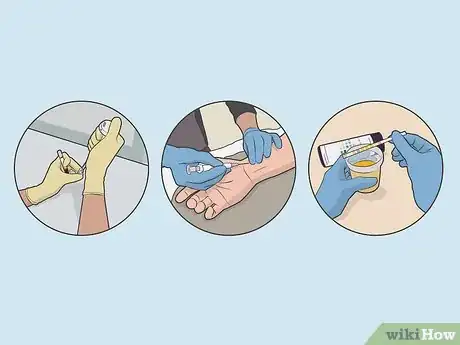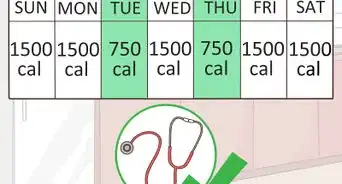This article was medically reviewed by Erik Kramer, DO, MPH. Dr. Erik Kramer is a Board-Certified Primary Care Physician at the University of Colorado. With over 15 years of experience, his clinical interests include obesity and weight management, diabetes care, and preventive care, as well as embracing a holistic approach to primary care. He received his Doctorate in Osteopathic Medicine (D.O.) from the Touro University Nevada College of Osteopathic Medicine and completed his residency at Central Maine Medical Center. Dr. Kramer is a Diplomate of the American Board of Obesity Medicine.
There are 12 references cited in this article, which can be found at the bottom of the page.
This article has been viewed 9,039 times.
Metabolic acidosis is a condition where the acidity level in your body is too high, and it can be caused by several different things, like kidney failure, diabetes, or dehydration.[1] Some common symptoms are nausea, lethargy, headache, or rapid and shallow breathing. Because these symptoms can appear with many conditions, you must visit your doctor to get an actual diagnosis of metabolic acidosis. Each type of acidosis has its own treatment plan, and your doctor will need to run tests to determine which course of action will be best for you. Never try to diagnose and treat your symptoms on your own.
Steps
Determining the Cause of Metabolic Acidosis
-
1Visit a doctor to find out more about what is causing your acidosis. The symptoms of metabolic acidosis aren’t always apparent and the only way to know for sure that you have it is to have tests run by your doctor. Essentially, they’ll be testing your blood to determine its pH level, and from there they will run more tests to see what is causing that abnormal level in the first place.[2]
- In most cases, you’ll be at the doctor for some other reason and the metabolic acidosis will be discovered through your bloodwork. It’s generally a symptom of something else rather than a disorder of its own.
- Common causes of metabolic acidosis may include increased acid generation, loss of sodium bicarbonate, and diminished renal acid excretion.
-
2Check for diabetic ketoacidosis if you have type 1 or type 2 diabetes. With diabetic ketoacidosis, your body isn’t producing enough insulin and your blood and urine are getting overwhelmed with ketones. It’s a serious condition that may require anything from taking an extra shot of insulin to being hooked up to an IV to replace lost fluids.[3]
- If you are diabetic and experience the following symptoms, call your doctor or go to the emergency room right away: vomiting, inability to keep fluids down, severe nausea, or inability to regulate blood sugar levels.
Advertisement -
3See a doctor after having diarrhea to check for hyperchloremic acidosis. Diarrhea and extreme dehydration can cause hyperchloremic acidosis due to a loss of salts and organic acid anions. Your doctor will need to replenish your fluids through an IV and test your electrolytes to make sure they rebound to an appropriate level.[4]
- The most common symptoms of hyperchloremic acidosis are headache, vomiting, nausea, and lethargy. These are symptoms you might have from being dehydrated anyway, so it’s always best to see your doctor to make sure you’re getting the right treatment to bring you back to health.
-
4Pay attention to signs that you may have a buildup of lactic acid. Lactic acidosis is a form of metabolic acidosis that is caused by too much lactic acid, which can be caused by many different things: excessive alcohol consumption, cancer, over-exercising, liver failure, severe anemia, shock, seizure, and heart failure. Watch out for these symptoms and visit your doctor as soon as possible to determine if the cause is acidosis:[5]
- Disorientation
- Yellowing of the skin or eyes
- Rapid or shallow breathing
- Rapid heart rate
- Muscle cramping
- Fatigue
- Headaches
- Diarrhea
- Your doctor will treat the underlying cause of the lactic acidosis, so your treatment plan will differ based on that.
-
5Follow your treatment plan if you are dealing with kidney disease. If you have low-functioning kidneys, they may not be able to get rid of excess acid, causing you to develop metabolic acidosis. This is something your doctor will be aware of and test for regularly, so make sure to attend all your appointments.[6]
- Your doctor may choose to have you take sodium bicarbonate pills to help offset the level of acid in your body, and there may be other treatment methods they consider. Always follow your doctor’s advice and check with them before trying any treatments on your own.
Getting Tested for Metabolic Acidosis: There are 3 main tests your doctor may do to see if you have this condition:
Anion gap test through a basic metabolic panel: this measures your blood’s chemical balance to see if it is overly acidic.
Arterial blood gases test: this measures your blood’s pH level, as well as the oxygen and carbon dioxide levels. This test is usually done if you visit the Emergency Department, but it may be performed as an out-patient test. The test can be quite painful.
Urine test: this could reveal metabolic acidosis due to kidney issues, diabetes, or certain other health issues, like excessive alcohol consumption or poisoning.
Treating and Preventing Metabolic Acidosis
-
1Take sodium bicarbonate to raise the pH level in your blood. Sodium bicarbonate is found in many over-the-counter antacids because it does a great job reducing the amount of acid in your body. So when you’re dealing with extreme metabolic acidosis, your doctor may ask you to take sodium bicarbonate pills to help offset excess acid in your blood or urine.[7]
- For more extreme cases of metabolic acidosis, your doctor may give you intravenous sodium bicarbonate.
Warning: Do not take sodium bicarbonate unless it is prescribed to you by your doctor. Over-the-counter antacids are safe, of course, but concentrated sodium bicarbonate could interact with other medications you may already be taking.
-
2Get insulin therapy or electrolyte replacement for diabetic ketoacidosis. If this is needed, your doctor will have you treated in a hospital right away. Depending on your blood sugar and pH levels, you may be hooked up to an IV to receive fluids, electrolytes, and possibly insulin. Vigorous IV fluid replacement, usually normal saline, is a significant part of treatment. This is typically necessary when a patient is hypervolemia or extremely dehydrated.[8]
- Once your levels are back to normal, you may be able to go home and resume your normal activities, or you made need to undergo additional testing. In some cases, you may need antibiotics or further evaluation before your doctor will let you go home.
-
3Undergo dialysis for renal failure based on a doctor’s recommendation. Dialysis will help your kidneys filter out excess waste while maintaining a healthy balance of acidity. Your doctor will let you know if this is needed.[9]
- Renal failure is also known as kidney failure, which is a common symptom of kidney disease.
- In general, people undergoing dialysis treatment receive it 3-4 times a week, and each session usually takes 3-4 hours. Depending on your circumstances, though, this could differ.
-
4Add low-acid foods to your daily diet. If you struggle with metabolic acidosis for any reason, it can help to alter your diet so you aren’t consuming more acid than is necessary. Soy, oatmeal, unsweetened yogurt and milk, ginger, fresh fruits and vegetables, seafood, parsley, beans, lentils, and herbal teas are low in acidity and can help neutralize the level of acid in your gut, giving your kidneys less to process.[10]
- “Clean eating” or focusing on adding more whole foods to your diet could help your body maintain a normal acidity level.
- If you think you may have metabolic acidosis based on your symptoms, always visit your doctor before trying to fix things through your diet. There may be something more serious going on.
-
5Avoid high-acid foods to not introduce extra acid to your system. Meat, cheese, eggs, sugar, grain, processed foods, soda, and protein-rich supplements or foods will increase the amount of acid in your body. Limit how many of these you include in your daily diet.[11]
- Visit a nutritionist or dietician to learn more about how different foods can affect your acidity levels.
-
6Drink 8-10 glasses of water every day to avoid becoming dehydrated. Especially if you are struggling with vomiting, diarrhea, or anything else that could be draining your body of fluids, it’s especially important to rehydrate. Keep a water bottle with you at all times, drink a big glass of water first thing in the morning, and set reminders for yourself throughout the day.[12]
- When you exercise, you often sweat out a lot of important electrolytes. Consider using a sports drink or coconut water to replenish your electrolytes.
- If you do drink sports drinks, pay attention to the sugar and carb content and try to pick a brand that is lower-sugar and lower-carb.
-
7Stretch after you exercise to release excessive lactic acid. In addition to staying hydrated, incorporating post-workout stretching will help your body process any built-up lactic acid. You could also use a foam roller or get a massage.[13]
- Exercising regularly can also help decrease the amount of lactic acid in your body. The better shape your body is in, the easier your muscles will recover after you exercise. Aim to workout 5 days a week for 30 minutes at a time.
Warnings
- Do not take any medications or pills without first consulting with your doctor. Depending on your situation, they could interfere with other medications or treatments you are already using.⧼thumbs_response⧽
References
- ↑ https://medlineplus.gov/ency/article/000335.htm
- ↑ https://www.merckmanuals.com/professional/endocrine-and-metabolic-disorders/acid-base-regulation-and-disorders/metabolic-acidosis
- ↑ https://www.pennmedicine.org/for-patients-and-visitors/patient-information/conditions-treated-a-to-z/metabolic-acidosis
- ↑ https://www.ncbi.nlm.nih.gov/books/NBK482340/
- ↑ https://www.merckmanuals.com/professional/endocrine-and-metabolic-disorders/acid-base-regulation-and-disorders/lactic-acidosis
- ↑ https://www.kidney.org/atoz/content/metabolic-acidosis
- ↑ https://www.merckmanuals.com/professional/endocrine-and-metabolic-disorders/acid-base-regulation-and-disorders/metabolic-acidosis
- ↑ https://www.msdmanuals.com/professional/endocrine-and-metabolic-disorders/acid-base-regulation-and-disorders/metabolic-acidosis
- ↑ https://www.kidney.org/atoz/content/dialysisinfo















-Step-12-Version-2.webp)
















-Step-12-Version-2.webp)



































Medical Disclaimer
The content of this article is not intended to be a substitute for professional medical advice, examination, diagnosis, or treatment. You should always contact your doctor or other qualified healthcare professional before starting, changing, or stopping any kind of health treatment.
Read More...